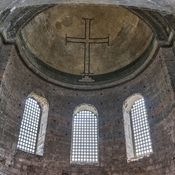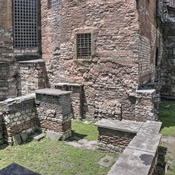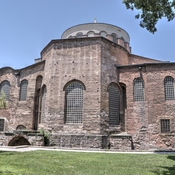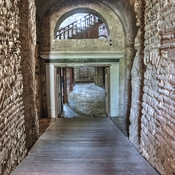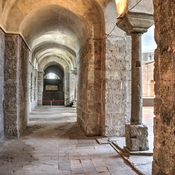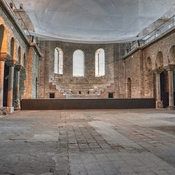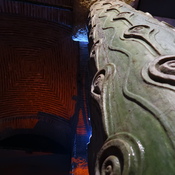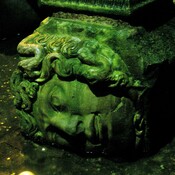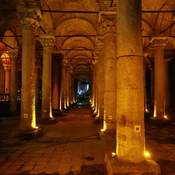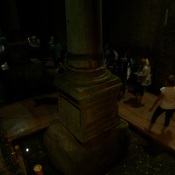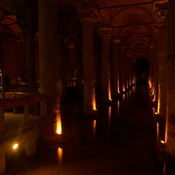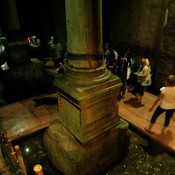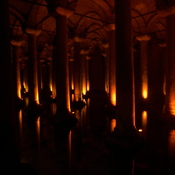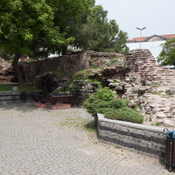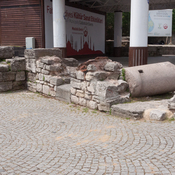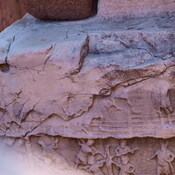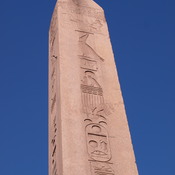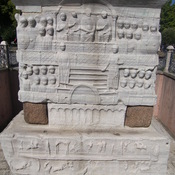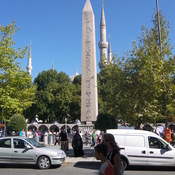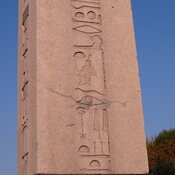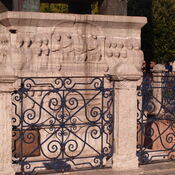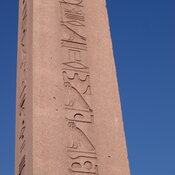Il n'y a pas une annotation en français. Présenté est une annotation en Anglais.
Constantinople (İstanbul): Hagia Sophia. The main church of Constantinople, the Church of the Divine Wisdom. It was built near an older Christian sanctuary, the Church of Heavenly Peace or S. Irene. http://www.livius.org/cn-cs/constantinople/constantinople_hagia_sophia.html
Today's Hagia Sophia is the third building constructed in the same place with a different architectural understanding than its predecessors. By the order of Emperor Justinianos, it was built by Anthemios from Tralles (Aydin) and Isidoros from Miletos (Balat). The construction started in 532 and was completed in a period of five years and opened for worship in 537 with great ceremony. When Sultan Mehmet the Conqueror conquered the city, he converted it into his imperial mosque. Buttresses were added to the Hagia Sophia’s sides to prevent it from collapse during the reign of Murad III by the historical architect Sinan who would be inspired by the ancient edifice, and fusing its style with Islamic art and aesthetics in a series of Grand Mosques. The Hagia Sophia, whose domes and walls collapsed many times during the Eastern Roman period, never collapsed again after the renovations of Sinan the Architect despite many great earthquakes in Istanbul.
From the time of Fatih Sultan Mehmet Khan, every sultan strived to beautify the Hagia Sophia even more, and the Hagia Sophia was transformed into an entire complex with structures such as mihrab, minbar, rostrum, minarets, sultan’s office, shadirvans (fountain providing water for ritual ablutions), madrasah, library, and soup kitchen. In addition, great importance was attached to the interior decorations of the Hagia Sophia Mosque during the Ottoman period. Hagia Sophia was adorned with the most elegant examples of Turkish arts such as calligraphy and tile art and the temple gained new aesthetic values. Thus, Hagia Sophia was not only converted into a mosque but also this common heritage of humanity was preserved and improved. It continued its existence with the addition of Ottoman architectural elements, however Hagia Sophia Mosque declared as a museum with the Council of Ministers Decision dated 24.11.1934 and served as a “Memorial Museum” held by General Directorate of Cultural Heritage and Museums Ministry.
On July 10/2020, a Turkish top court reversed this 1934 Cabinet decree which turned Hagia Sophia Mosque into a museum, assist for its use again as a mosque after 86-year of gap. Judges decided that as the Hagia Sophia was owned by the Fatih Sultan Mehmet Khan Foundation, the government did not have the right to change its status. The opening ceremony for worship in Hagia Sophia Mosque held on 24 July 2020, with the attendance of President of the Republic of Turkey Mr. Recep Tayyip Erdoğan. Before the prayers, President Erdoğan recited from the Qur'an inside the reverted mosque, choosing verses from both the Surah Al-Fatihah and the Surah Al-Baqarah. Some 350,000 people participated in traditional Friday prayers at Istanbul's historic Hagia Sophia Mosque.
Official Website: https://muze.gen.tr/muze-detay/ayasofya
Constantinople (İstanbul): Hagia Sophia. The main church of Constantinople, the Church of the Divine Wisdom. It was built near an older Christian sanctuary, the Church of Heavenly Peace or S. Irene. http://www.livius.org/cn-cs/constantinople/constantinople_hagia_sophia.html
Today's Hagia Sophia is the third building constructed in the same place with a different architectural understanding than its predecessors. By the order of Emperor Justinianos, it was built by Anthemios from Tralles (Aydin) and Isidoros from Miletos (Balat). The construction started in 532 and was completed in a period of five years and opened for worship in 537 with great ceremony. When Sultan Mehmet the Conqueror conquered the city, he converted it into his imperial mosque. Buttresses were added to the Hagia Sophia’s sides to prevent it from collapse during the reign of Murad III by the historical architect Sinan who would be inspired by the ancient edifice, and fusing its style with Islamic art and aesthetics in a series of Grand Mosques. The Hagia Sophia, whose domes and walls collapsed many times during the Eastern Roman period, never collapsed again after the renovations of Sinan the Architect despite many great earthquakes in Istanbul.
From the time of Fatih Sultan Mehmet Khan, every sultan strived to beautify the Hagia Sophia even more, and the Hagia Sophia was transformed into an entire complex with structures such as mihrab, minbar, rostrum, minarets, sultan’s office, shadirvans (fountain providing water for ritual ablutions), madrasah, library, and soup kitchen. In addition, great importance was attached to the interior decorations of the Hagia Sophia Mosque during the Ottoman period. Hagia Sophia was adorned with the most elegant examples of Turkish arts such as calligraphy and tile art and the temple gained new aesthetic values. Thus, Hagia Sophia was not only converted into a mosque but also this common heritage of humanity was preserved and improved. It continued its existence with the addition of Ottoman architectural elements, however Hagia Sophia Mosque declared as a museum with the Council of Ministers Decision dated 24.11.1934 and served as a “Memorial Museum” held by General Directorate of Cultural Heritage and Museums Ministry.
On July 10/2020, a Turkish top court reversed this 1934 Cabinet decree which turned Hagia Sophia Mosque into a museum, assist for its use again as a mosque after 86-year of gap. Judges decided that as the Hagia Sophia was owned by the Fatih Sultan Mehmet Khan Foundation, the government did not have the right to change its status. The opening ceremony for worship in Hagia Sophia Mosque held on 24 July 2020, with the attendance of President of the Republic of Turkey Mr. Recep Tayyip Erdoğan. Before the prayers, President Erdoğan recited from the Qur'an inside the reverted mosque, choosing verses from both the Surah Al-Fatihah and the Surah Al-Baqarah. Some 350,000 people participated in traditional Friday prayers at Istanbul's historic Hagia Sophia Mosque.
Official Website: https://muze.gen.tr/muze-detay/ayasofya




